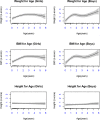Determinants of Anishinabeck infant and early childhood growth trajectories in Northwestern Ontario, Canada: a cohort study
- PMID: 38115010
- PMCID: PMC10729431
- DOI: 10.1186/s12887-023-04449-5
Determinants of Anishinabeck infant and early childhood growth trajectories in Northwestern Ontario, Canada: a cohort study
Abstract
Background: The Developmental Origins of Health and Disease (DOHaD) paradigm emphasizes the significance of early life factors for the prevention of chronic health conditions, like type 2 diabetes (T2DM) and obesity, which disproportionately affect First Nations communities in Canada. Despite increasing DOHaD research related to maternal health during pregnancy, early childhood growth patterns, and infant feeding practices with many populations, data from First Nations communities in Canada are limited. In partnership with Sandy Lake First Nation, the aims of this project were to characterize birthweights and growth patterns of First Nations infants/children over the first 6 years of life and to study the impact of maternal and infant social and behavioral factors on birthweight and growth trajectories.
Methods: We recruited 194 families through community announcements and clinic visits. Infant/child length/height and weight were measured at 1 and 2 weeks; 1, 2, 6, 12, and 18 months; and 2, 3, 4, 5 and 6 years. Maternal and infant/child questionnaires captured data about health, nutrition, and social support. Weight-for-Age z-score (WAZ), Height-for-Age z-score (HAZ), and BMI-for-Age z-score (BAZ) were calculated using WHO reference standards and trajectories were analyzed using generalized additive models. Generalized estimating equations and logistic regression were used to determine associations between exposures and outcomes.
Results: WAZ and BAZ were above the WHO mean and increased with age until age 6 years. Generalized estimating equations indicated that WAZ was positively associated with age (0.152; 95% CI 0.014, 0.29), HAZ was positively associated with birthweight (0.155; 95% CI 0.035, 0.275), and BAZ was positively associated with caregiver's BMI (0.049; 95% CI 0.004, 0.090). There was an increased odds of rapid weight gain (RWG) with exposure to gestational diabetes (OR: 7.47, 95% CI 1.68, 46.22). Almost 70% of parents initiated breastfeeding, and breastfeeding initiation was modestly associated with lower WAZ (-0.18; 95% CI -0.64, 0.28) and BAZ (-0.23; 95% CI -0.79, 0.34).
Conclusions: This work highlights early life factors that may contribute to T2DM etiology and can be used to support community and Indigenous-led prevention strategies.
Keywords: Breastfeeding; Child growth; Diabetes; First Nations; Indigenous health; Infant nutrition; Maternal health; Obesity.
© 2023. The Author(s).
Conflict of interest statement
The authors declare no competing interests.
Figures





References
-
- Agarwal P, Morriseau TS, Kereliuk SM, Doucette CA, Wicklow BA, Dolinsky VW. Maternal obesity, diabetes during pregnancy and epigenetic mechanisms that influence the developmental origins of cardiometabolic disease in the offspring. Crit Rev Clin Lab Sci. 2018;55(2):71–101. doi: 10.1080/10408363.2017.1422109. - DOI - PubMed
-
- McNamara BJ, Gubhaju L, Chamberlain C, Stanley F, Eades SJ. Early life influences on cardio-metabolic disease risk in aboriginal populations–what is the evidence? A systematic review of longitudinal and case-control studies. Int J Epidemiol. 2012;41(6):1661–1682. doi: 10.1093/ije/dys190. - DOI - PubMed
Publication types
MeSH terms
Grants and funding
LinkOut - more resources
Full Text Sources
Medical

